Enhance Stewardship and Management of State Park and Forest Lands
The major DCNR accomplishments of 2022 to enhance the stewardship and management of state park and forest lands are listed below.
Three New State Parks
In September 2022, Governor Wolf announced the locations for three new parks being added to the 121-state park system to create new recreational opportunities to meet high demand and to conserve nearly 3,500-acres of vital natural and cultural resources.
The new parks are expected to be fully operational and ready to be enjoyed by the end of 2026. With the three new state parks and the addition of Washington Crossing Historic Park in 2015, more state parks were added under the Wolf Administration since the Maurice K. Goddard/Project 70 era.
The new parks are:
Susquehanna Riverlands, York County
Susquehanna Riverlands State Park in Hellam Township, York County includes 1,100 acres of natural resources. The largely wooded tract, located where Codorus Creek flows into the Susquehanna River, protects critical water and forest resources.
The land was acquired with assistance from the Lancaster Conservancy and is adjacent to its Hellam Hills and Wizard Ranch nature preserves. Combined, they protect the last large, wooded area along the Susquehanna River between the cities of Harrisburg, York, and Lancaster.
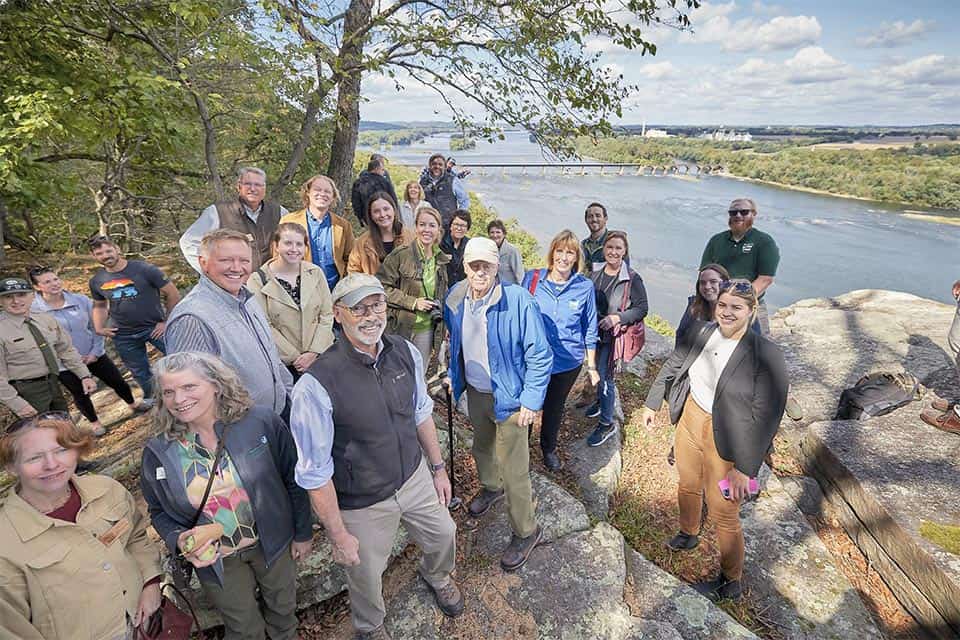
Governor Tom Wolf and DCNR joined many partners to celebrate Susquehanna Riverlands State Park
Vosburg Neck, Wyoming County
Vosburg Neck State Park is 669 acres being acquired with the assistance of the North Branch Land Trust.
The park will offer scenic hiking opportunities, including a climb to an impressive westerly oriented vista, pleasant strolls along a former railroad bed, invigorating shared-use trails, and significant public access for water-based recreation to the North Branch of the Susquehanna River.
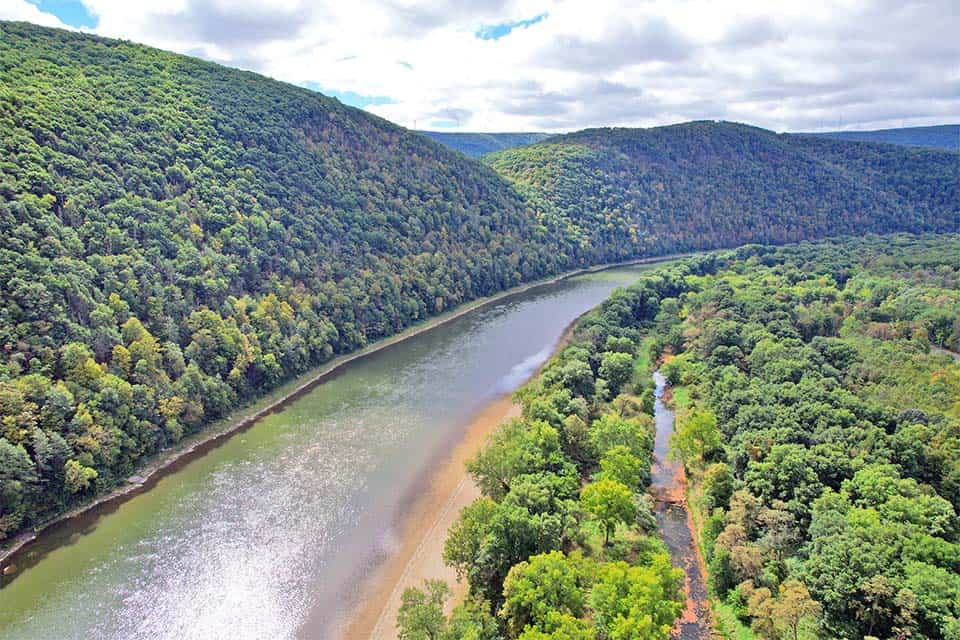
Vosburg Neck State Park protects a large forested area along an oxbow on the north branch of the Susquehanna River
Big Elk Creek, Chester County
Big Elk Creek State Park is 1,712 acres acquired through The Conservation Fund with the assistance of the Mt. Cuba Center and Chester County. It features 3.5 miles of Big Elk Creek, a tributary of the Elk River and the Chesapeake Bay.
Big Elk Creek was an important transportation and natural resource corridor for indigenous people for thousands of years and an important area for freedom seekers on the Underground Railroad to the North.
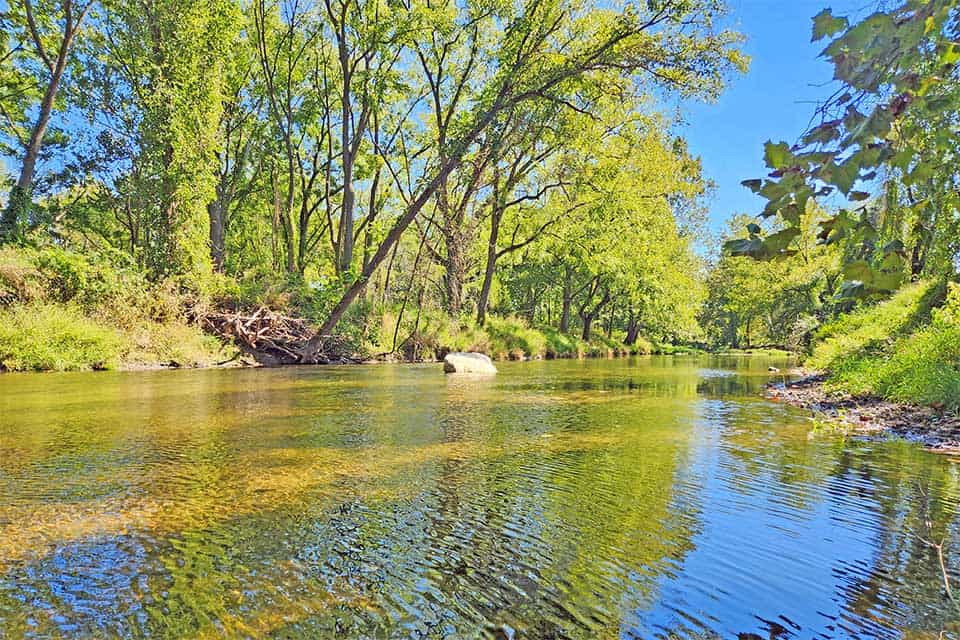 Big Elk Creek becomes the Elk River and flows directly into the Chesapeake Bay
Big Elk Creek becomes the Elk River and flows directly into the Chesapeake Bay
State Park Land Acquisitions
Land acquisitions secured more than 500 additional state park acres for hunting and several new stream-access opportunities for anglers.
State Forest Land Acquisitions
The Bureau of Forestry added 5,800 acres to the state forest system to improve recreational access, enhance carbon storage, protection of ecological resources and sustainable management of timber for wood products.
Catawissa Recreation Area
Tentatively set to open in the summer of 2023, the Catawissa Recreation Area is a 5,541-acre parcel of land that will be developed into a motorized recreation area in the Weiser Forest District in Schuylkill and Luzerne counties. DCNR is working with the Larson Design Group and The Markosky Engineering Group to develop the master plan for the recreation area.
Infrastructure Investments
DCNR has assessed more than $1.4 billion in funding needs for repairs and is working with state and federal officials to identify funding for those needs. A $75 million state investment in the 2022-23 budget will be used as a down payment to address infrastructure needs across public lands
Projects to maintain and improve the vast state park and forest infrastructure continued in 2022. Highlights include:
Washington Crossing Historic Park
An $8.7 million project to preserve and improve 17 historic and other structures at the park in Bucks County was completed in December, enhancing the beauty of the 500-acre park that lies along the Delaware River preserves the site of George Washington’s dramatic boat crossing during the American Revolution.
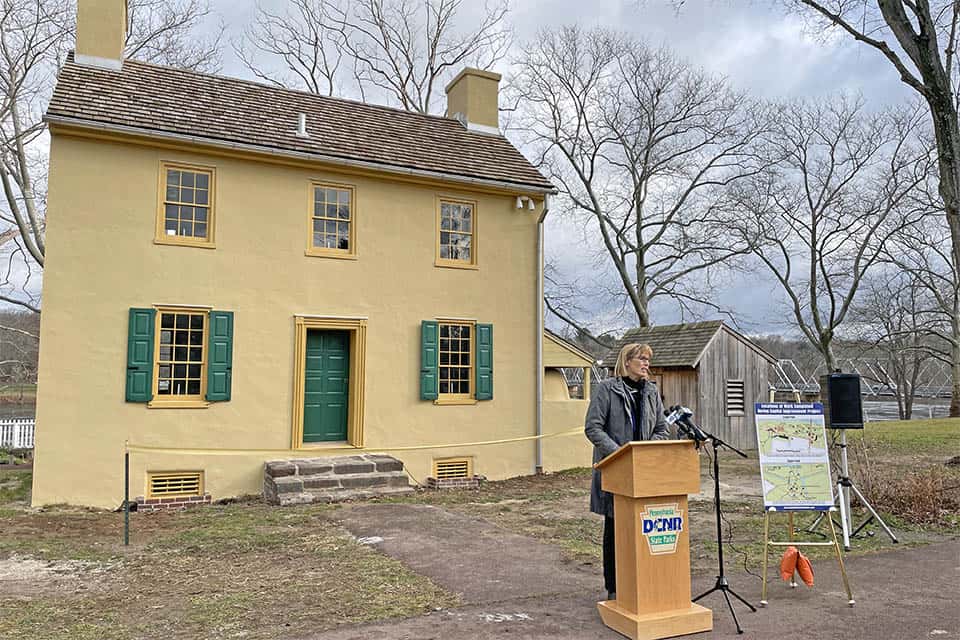
DCNR completed the preservation of 17 historic structures at Washing Crossing Historic Park
Pinchot State Forest
Removal of the high-hazard Laurel Run Dam Number Two along Laurel Run in Plains Township, Luzerne County in the Pinchot Forest District will address public safety and restore the Laurel Run corridor and ecosystem to a Class A wild trout stream.
DCNR’s bureaus of Forestry and Facilities, Design and Construction developed the plan for removal of the 37-foot high, 298-foot-long dam, which was built in 1885 and was deemed to be a high-hazard dam by the state Department of Environmental Protection.
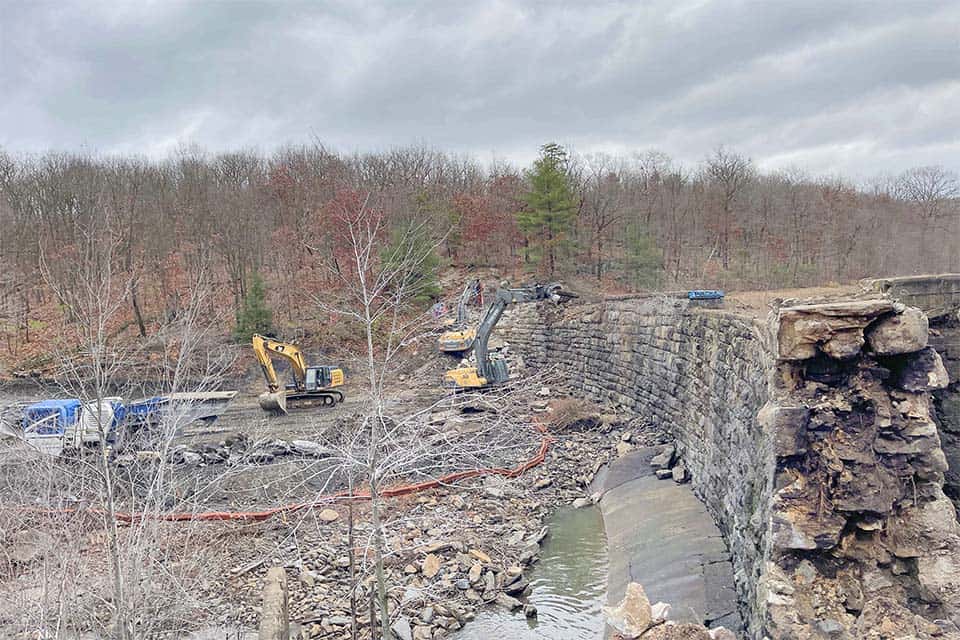
Removal of Laurel Run Dam Number Two will restore the natural stream bed and ensure public safety
Lehigh Gorge State Park
A $5 million rehabilitation project at Lehigh Gorge State Park was completed in late 2022, giving the public access to a new, modern, year-round restroom facility, improved public boat launch, and upgraded parking areas. Access to Middleburg Road and trail from downtown White Haven to the railroad underpass has also been restored.
In addition to improving park amenities, parking and access, the project also will help improve surface and groundwater quality and quantity.
Yellow Creek State Park
Work began at Yellow Creek State Park including new pavilions, repaving the roadways and parking areas, replacing the boat concession building, ADA accessibility improvements and floodplain mitigation.
Seven Tubs Recreation Area
A $1.5 million infrastructure project at the recreation area began in 2022, which includes construction at the Route 115 entrance, restoring the roads on Bear Creek Boulevard, parking lot expansion, development of pedestrian walkways, stormwater management improvements and access to the popular D and L Trail.
Shikellamy State Park
Repairs to the Adam T. Bower Memorial Dam were completed, allowing an abbreviated boating season on Lake Augusta. Park officials are hoping to begin work on the second phase of the marina project in the near future.
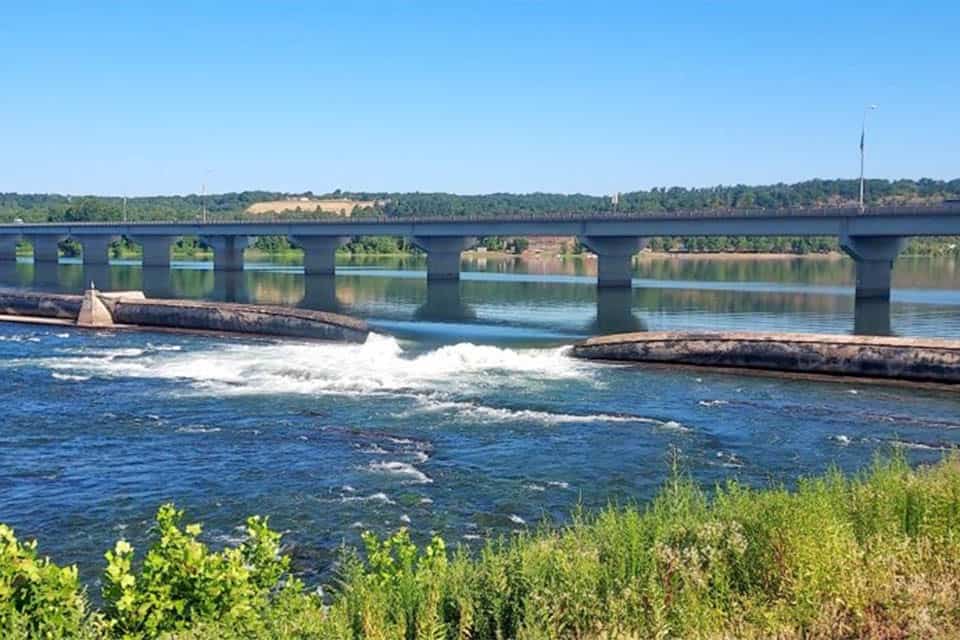
The Adam T. Bower Memorial Dam creates Lake Augusta at Shikellamy State Park
Commonwealth Service
DCNR supported Wolf Administration efforts to protect public health and provide resources to Pennsylvania voters by providing vaccine clinics at several state parks and having voter registration information at many locations across public lands.
Climate Change Adaptation
Numerous infrastructure projects were undertaken to adapt to climate change in 2022. Wastewater rehabilitation projects were completed at Locust Lake and Neshaminy State Parks to overhaul failing infrastructure thereby lowering the potential for hydraulic overload.
To improve surface and groundwater quality and quantity, the White Haven Public Access Area at Lehigh Gorge State Park underwent a $5 million rehabilitation project.
The Moon Lake outlet structure in Pinchot State Forest was replaced to combat increased flooding and runoff that would overwhelm and damage infrastructure.
In Loyalsock State Forest, Mill Creek Road was relocated away from the stream to prevent washout of embankments from heavy rain events.
The Glade Road Bridge over Blue Hole Creek in Forbes State Forest underwent replacement to armor the embankments and size the hydraulic opening for 100-year storm events.
And in Rothrock State Forest, Tea Creek Dam was removed to allow for the flow of cooling waters and migration of aquatic life.
Park Waste Reduction
Beginning with concession agreements that expired in 2020, DCNR incorporated new language into the agreements that will help reduce the amount of waste generated at park facilities, divert waste from landfills by way of composting, and prohibit materials that are deleterious to the environment.
To date 25 agreements have been executed with another 20 additional agreements up for bid in 2023. These contracts also encourage recycling of materials and more waste recovery and diversion from landfills by incorporating composting at select locations where feasible.
Cultural Resource Management
DCNR hired a program coordinator to manage cultural resources in state forests in addition to the existing position with state parks. A total of 82 projects are underway or have been completed, greatly improving the speed and efficiency of cultural review while also maintaining DCNR’s responsibility for good stewardship of resources.
A seasonal Cultural Resources Crew was also created as a part of the Pennsylvania Outdoor Corps program run with the support of the Student Conservation Association (SCA). DCNR has the largest number of known cultural resources of significance on its lands than any other state agency.
Protecting Visitors Health
In cooperation with the Department of Health, DCNR again expanded its free sunscreen program at 33 state parks where dispensers are now located. The effort reached an estimated 1.5 million visitors to state park beaches and swimming pools. DCNR plans to again expand efforts to more state parks in 2023.
Road Maintenance -- Dirt and Gravel Roads Program
More than 20 road projects were funded with money from Dirt and Gravel Roads Program to safeguard watersheds and provide sound recreational and operational access to the state forest. DCNR continues to work with Center for Dirt and Gravel Roads and has drafted an administrative manual.
Sustainable Forest Management
For the fifth consecutive year, Forestry successfully passed its audit to maintain dual certification by the Forest Stewardship Council and the Sustainable Forestry Initiative. In 2022, the Sustainable Forestry Initiative released a revised standard, including new requirements focused on climate smart forestry and forest fire resilience and awareness.
DCNR has successfully met the elements of this revised standard. Meeting the rigorous criteria for certifications of both the Forest Stewardship Council and Sustainable Forestry Initiative ensures that state forests are managed to the highest third-party standards.
DCNR Strategic Wetland Program Plan
Forestry began the development of a Strategic Wetland Program Plan as part of a United States Environmental Protection Agency Wetland Program Development Grant, in coordination with the DCNR Bureau of State Parks. The plan will provide a framework for the assessment, protection, and restoration of wetlands on DCNR lands.
Timber Management
Forestry contracted for the harvesting of approximately 10,700 acres of timber on state forest land, providing about $16 million in revenue for the commonwealth.
While helping to maintain forest health, the Forest Stewardship Council and Sustainable Forestry Initiative-certified timber harvesting program provides renewable wood products to consumers, supports local jobs and industry, and creates early successional forests that benefit wildlife.
Woodland Stewardship
Service foresters provided forest management assistance to more than 1,534 private landowners and gave 264 presentations, reaching approximately 14,781 audience members. Together with forestry partners, bureau staff helped educate more than 33,823 forest landowners through educational webinars and outreach materials.
The bureau has also been working hard on the creation of a pilot Private Forestland Enhancement Program, which will launch in 2023.
Deer Management Assistance Program (DMAP)
In 2022, DCNR was granted Deer Management Assistance Program coupons in 104 units in its continued effort to manage the deer population in vulnerable and severely impacted forest tracts.
Invasive Plant Management
DCNR continued its effort to control invasive plants across the state and treated approximately 1,000 acres of invasive plants in 2022. During the 2022 field season, across forest districts and ecological services, there were 78 new Early Detection Rapid Response detections. Of those, 38 were treated and five were eradicated.
Among the infrastructure areas monitored by the Gas Monitoring Data, there were seven new Early Detection Rapid Response detections. The Monitoring Crew treated 20 existing Early Detection Rapid Response populations, and one new population has been deemed eradicated.
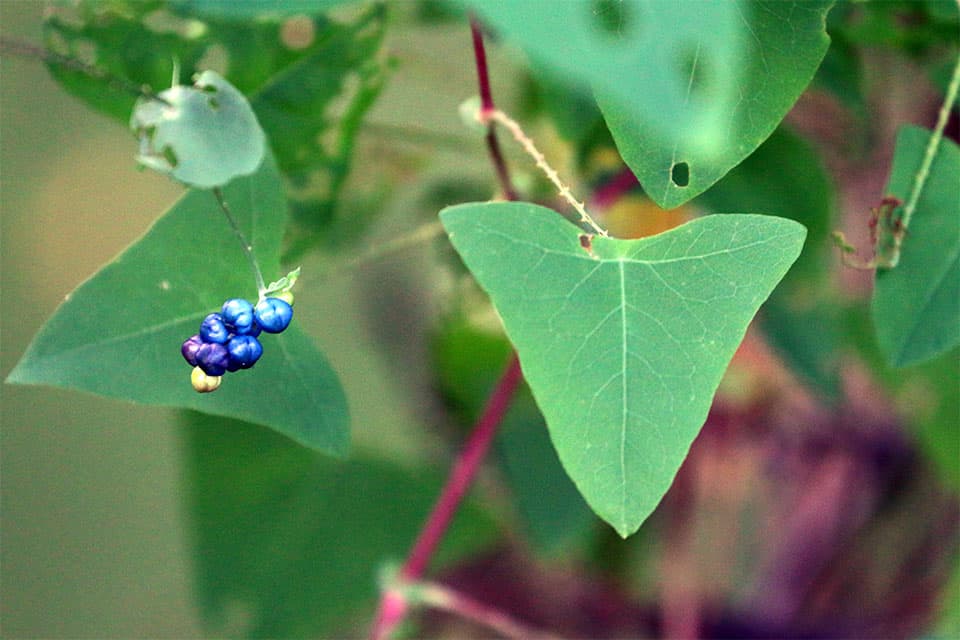
Mile a minute weed is one of the invasive plants that DCNR monitors and treats in state parks and forests
Old Growth Study
DCNR funded an old growth assessment study after discussions by the Bureau of Forestry Climate Change Committee determined its necessity.
Over a four-year timeframe, Pennsylvania Natural Heritage Program biologists will assess the quality and condition of Pennsylvania’s oldest forests, develop a rapid assessment protocol to define old growth characteristics distinctive to Pennsylvania, prioritize potential old growth stands for late successional management and recommend ecological management as needed.
Improving the health of old growth forests on state forest land will also increase carbon storage, helping mitigate the effects of climate change.